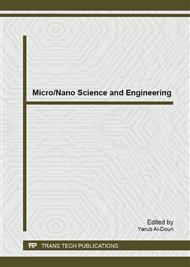p.48
p.52
p.57
p.62
p.67
p.72
p.77
p.82
p.84
Catalytic Pretreatments of Palm Tree Biomass for the Extraction of Lignin, Cellulose and Hemicelluloses
Abstract:
Lignocellulosic biomass consists of three polymeric components, namely cellulose, hemicellulose and lignin. Lignin is an amorphous polymer made by three different phenolic compounds, namely guaiacyl alcohol (G), syringyl alcohol (S) and p-coumaryl alcohol (H). It is the main component of cell walls and is composed of a 3D randomized net linked to cellulose and hemicelluloses. It functions as a biological barrier and glue to retain linked hemicelluloses and celluloses. Lignin and lignin derived compounds have important applications in paper and pulp industry as well as barrier thin film industry. On the other hand, cellulose and hemicelluloses are important feed stocks for biofuel, specialty chemicals and bio-surfactants. Degradation of lignin is a key step for the production of biofuel from biomass resources. Lignin can be depolymerized with enzyme and metal based catalyst, and acid peroxidases. Enzymatic approaches are green but expensive and slow. Acid peroxidases are often harsh, non-specific, and environmentally unfriendly and destroys lignin, cellulose and hemicelluloses. Several types of metal catalysts have been proposed for the selective cleavage of lignin. For example, nanoNi (O) was prepared by reducing of NiCl2 with NaBH4 under ultrasonication, Fe3O4 (NiAlO)x was prepared by calcination of Mg (Ni)-Al hydrotalcite with incorporation of Fe3O4 followed by reduction with hydrogen, and NiO nanosheets were synthesized by reduction of Ni (NO3)2 with urea using benzyl alcohol as a structure directing agent. These metal based catalysts demonstrated promising results by depolymerizing lignin under thermal ultrasonic conditions. This paper reviewed various catalysts, their synthesis processes and mechanistic actions for the pretreatment of palm tree biomass for the extraction of all three components, namely cellulose, hemicelluloses and lignin.
Info:
Periodical:
Pages:
67-71
Citation:
Online since:
April 2014
Price:
Сopyright:
© 2014 Trans Tech Publications Ltd. All Rights Reserved
Share:
Citation:


